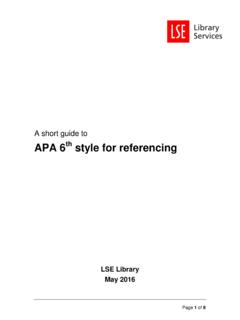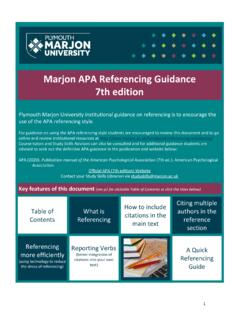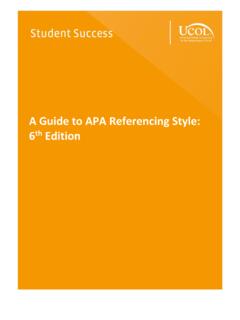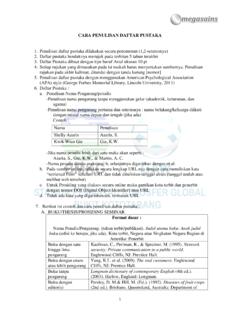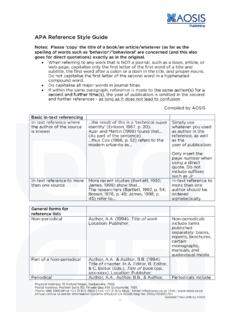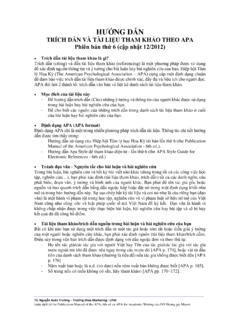Transcription of Sample Capstone Paper APA Format - My Assignment Help
1 Running head: WRITE A SHORTENED TITLE USE ALL CAPITAL LETTERS 1 Full Title of the Proposal Author s Name: (no professional initials such as Dr., Prof.) Institutional Affiliation: (for example ABCD-School of Nursing) Capstone Chair: Type the name of your academic advisor here Capstone Committee Member: Type the name of your committee member here Date of Submission: Month, Day, Year SHORTENED VERSION OF PROPOSAL 2 Table of Contents Abstract .. 3 Introduction and Background .. 5 Problem Statement .. 6 Aims and Objectives .. 6 Literature Review .. 6 Theoretical Model .. 8 Project and Study Design .. 8 Setting and Resources .. 9 Group I Location.. 9 Group II Location.. 9 Study Population .. 9 Sources of Data .. 9 Data Analysis .. 9 Quality .. 10 Ethics and Human Research Subjects Protection .. 10 Timeframes or Timeline .. 10 Budget .. 10 Strengths and Limitations of the Study.
2 10 Conclusion .. 10 References .. 12 References .. 13 Appendix .. 14 Basic APA, 6th ed., Citation 14 SHORTENED VERSION OF PROPOSAL 3 Abstract The purpose of this template is to guide you as you develop your Capstone project proposal in apa style , 6th edition. The template may not work as effectively for a systematic review proposal, though. It provides different sections, headings, and subheadings normally usually included in a Capstone proposal. The other areas covered by this document are line and paragraph spacing, page numbering, page breaks, and editorial/formatting/ referencing styles . Look at this document s formatting. You ll notice that this template allows one-inch margins on all sides, that is, the right, left, top, and top margins. You should use 12-point Times New Roman style. We ve double-spaced it, aligned it flush left, and indented paragraphs inches from the left margin.
3 To indent, simply press the tab key just once. Note that we ve not indented the abstract; you shouldn t either. You should position your page numbers one inch away from the right margin, at the right top corner. With MS Word, inserting page numbers in apa style should be pretty easy. In apa style , you should always allow two spaces between sentences. If you wish to use this template, simply insert each section of your work where it should go. This section of the template is an example of what your Capstone proposal s abstract should look like. An abstract should be roughly 250 words long. It is a paragraph that succinctly summarizes your Capstone proposal. You should write the abstract last. Why? You can t summarize content you don t have! The abstract presents an overview of the background, literature review, purpose, method, findings/results, discussion, and conclusion sections of the proposed project.
4 Your abstract should not contain personal comments, that is, it is supposed to be non-evaluative. Also, it doesn t need citations. Your abstract should list the keywords that indicate what your proposal discusses. Keywords refer to the words that helped you perform database searches for your proposal. SHORTENED VERSION OF PROPOSAL 4 If you need to learn more about apa style 6th edition, visit these two websites and Here are the Keywords for this template: apa style , sixth edition, publication manualSHORTENED VERSION OF PROPOSAL 5 Introduction and Background The introductory section includes a couple of paragraphs that present an overview of your topic as well as relevant background information. Tell readers why your study s problem matters. Argue that the project you propose to carry out serves an important purpose. Support your argument with findings from existing literature.
5 Provide relevant statistics, citing them in apa style , 6th edition. O'Leary (2010) states that the purpose of the introductory section is to show readers that the issue you want to study is significant and worth exploring" (p. 64). Be sure to document in the body of your Paper every source you mention in the introductory section. How you write your citations depends on the specific formatting style you re using. Whether it is apa 6th edition, MLA 8thedition or Chicago 17th edition, ensure you follow the applicable referencing rules. (See Appendix A for basic information on citations). But we re using APA here, and we ll show you how apa style works. Remember: each in-text citation must correspond to a full reference appearing on a separate reference list known as References. The reference page included at the end of this document provides examples of how you should create citations for different types of references.
6 Notice that we have created a hanging indent for almost every entry on the references page. To do that, we ve set the first line of the citation flush left. We ve indented all subsequent lines in each reference. Look at this full citation (it s one of the references we present at end of this writing): American Psychological Association. (2010). Publication manual of the American Psychological Association (6th ed.). Washington, DC: Author. Look at the reference above. You ll see that we ve indented the second line. We wouldn t have indented this citation had it consisted of only one line of text. Please remember that it s important. SHORTENED VERSION OF PROPOSAL 6 Problem Statement The introduction section naturally flows into your Capstone proposal s problem statement section. The reader should feel that you ve smoothly and logically transitioned them from the intro to this part of the proposal.
7 At this point, you should present your inquiry question. Your inquiry question provides the direction your work should follow all the way through its conclusion. Most importantly, you should explain your approach to the problem at hand. Also, you need to describe how your approach addresses that problem. Aims and Objectives Just as the name suggests, this section explains the aims and objectives of your proposed Capstone project. O'Leary (2010) asserts that proposals have one chief aim that encapsulates what your project hopes to achieve. O Leary also says that you should include a set of smaller objectives (specific goals) whose job is to support your study s central aim. Aims and objectives are actions you intend to perform. That s why you should use to statements when writing down your aims and objectives. Examples of to statements include 'to' develop, 'to' investigate, to identify, to describe 'to' measure, to discuss, 'to' explain, or 'to' compare.
8 Literature Review Your literature review section should provide an in-depth, up-to-date state of knowledge regarding the specific topic you re studying. Review of literature entails more than merely summarizing studies that other researchers have performed on your topic. Go a step further and synthesize the principal concepts that define the material you ve read. You should identify any current trends, patterns, or knowledge gaps that exist in the literature. Don t stop there; see if you any relationships exist among the studies reviewed. Generally, you shouldn t review research that s older than five years. But you can in certain circumstances. Sometimes, an older source is SHORTENED VERSION OF PROPOSAL 7 the only reference available for a key fact you wish to offer your readers. If and when you use older, landmark studies, be sure to identify such sources as such. A review of literature is like a puzzle you put together using individual pieces from different sources of literature.
9 You aim to reveal a fresh description of the state of knowledge regarding your particular topic. The literature review for your proposal should provide context for the proposal as well as the Capstone project (assuming it gets approved). When you start crafting your narrative, clearly define your topic. Present relevant statistical data, strengthened by historical and up-to-date background information. Use subheadings (known as Level 2 headings) to organize your key results. Your Level 2 headings should use both upper and lower case letters. Also, you should type level 2 headings flush with your Paper s left side. See the Project and Methods Design section for Level 2 heading examples. Level 3 headings help you to subdivide your topics even further. Indent all Level 3 headings. Use lowercase letters and set them in bold type. End each Level 3 heading with a period. Visit Purdue Owl s Writing Center and the APA Manual websites for more information on the five different levels of headings in apa style 6th edition.
10 You can find that information here. The literature review section shows readers why they should care about your topic. Writing this section is an attempt to demonstrate that your proposed Capstone project is the solution that fully addresses the problem you set out to solve. In this section, you should explain how you intend to address your Paper s main problem. Your argument needs all the support it can get from your literature review. The next thing you should do is write down the findings you squeezed out of your literature review. The findings you include are those that are central to your topic. One mistake SHORTENED VERSION OF PROPOSAL 8 students frequently make is to merely describe a series of studies, believing they re doing a review of review. You can use direct quotes. However, you should use them sparingly. Direct quotes can help you explain or stress critical points.
